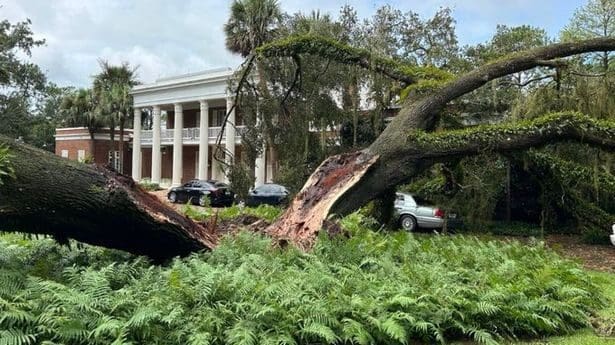The day Hurricane Idalia hit Tallahassee, Florida First Lady Casey DeSantis posted a photo of a split tree in the grounds of the Governor’s Mansion to her social media. Arborists and historians are taking an interest in the fate of that live oak.
People in Leon County tend to be proud of their trees and the canopy roads they provide. Stan Rosenthal, who was Leon County’s forester for 30 years, played a key role in creating that pride.
He says when a hurricane is Category 1, he and his wife stay put; when it gets to Category 2, they leave.
“Pine trees will start to break at the root system or snap off at Category 1s, even if they’re healthy and structurally sound,” he said. “Older water oaks and laurel oaks start breaking apart. You start to get into a Category 3, and live oaks – really sturdy trees, like this one, that don’t have that structural problem, good-sized branches and stuff start to break off.”
Rosenthal says trees can fail for a number of reasons. One is poor health; another is strong storms, like Idalia.
“Not every tree fell. Well, the ones that fell probably had some problem with them,” he said. “And so, health can be one of those, like a tree that has a rotten root system. Well, it’s doing pretty well, but when a strong wind hits it, it’s too much for it. Trees can flat-out die, and then as they decay, they’re more risky.”
Like all living things, trees die – not always of natural causes.
“Things we do to trees, like when we have developments, or we do construction work around a tree and we cut the root system,” he said. “The University of Florida did a bunch of research around hurricanes and trees, and we know that trees in older subdivisions did better than newer subdivisions because they didn’t have as much root damage.”
First Lady Casey DeSantis estimated the fallen tree’s age at roughly 100 years. Historian Jonathan Lammers has been studying aerial photos of the Governor’s Mansion to search for the tree in years past.
“And there’s no tree there in 1941. At that time, there was the previous Governor’s Mansion, which was torn down and rebuilt in 1956,” he said. “And based on an aerial photo from the mid-Sixties, it looks like the tree that fell down was most likely planted when the new Governor’s Mansion was built in the 1950s. And so, we’re looking at a tree that’s probably around 70 years old or so.”
Lammers says it takes 70 to 100 years for live oaks to get to adulthood.
“And once they get up to that size, you’re also looking at the fact that they are little islands, biological islands unto themselves,” he said. “There are communities of insects and birds and other animals that use these trees…They really are little arcs of life. And we would do better to think about our urban tree canopy in that way.”
Regardless of its age, the live oak at the Governor’s Mansion had become synonymous with the house at the time of its demise. On Thursday, WFSU went to the Governor’s Mansion to view the tree but wasn’t allowed on the grounds. Officers said the remains of the tree had already been removed.
9(MDA4MzU1MzUzMDEzMTkyMzAwMzY5MjY1Mw004))
9(MDA4MzU1MzUzMDEzMTkyMzAwMzY5MjY1Mw004))


